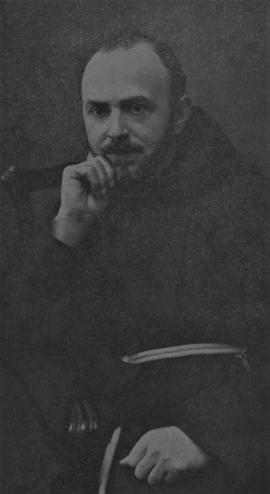Patrick J. Maher was born on North Brunswick Street, opposite, what was then, the Richmond Hospital in Dublin on 9 June 1835. His family’s property extended to North King Street and possibly included the site (No. 49) on which a former Capuchin House stood. He was baptized and made his first communion (8 September 1848) in the old Church Street chapel where he served Mass for Fr. Theobald Mathew OSFC from whom he took the total abstinence pledge. In 1851 he entered the Capuchin novitiate, taking the name Columbus, at Frascati near Rome, and made his solemn profession the following year. He then studied philosophy at Florence and theology at Sienna after which he was granted patents for preaching in 1855. The following year he received subdiaconate in Rome. Too young to be ordained, he spent some months with the Capuchin community in Pantasaph, Wales, until he returned briefly to Ireland to receive a diaconate from Cardinal Paul Cullen at Maynooth on 5 June 1857. The following year, at the age of twenty-three, he was ordained a priest in Liverpool with a dispensation of thirteen months from the Holy See. At the time it was noted that he was the first Capuchin priest to be ordained in England since the Reformation. At the Provincial Chapter in 1859 he was appointed guardian in Kilkenny where he served two terms and was in demand as a confessor and preacher until he was sent to Rome as a novice master. While there he was asked to go to Ancona to minister to about 800 men of the Irish Brigade who were on their way to defend Pope Pius IX.
Having returned to Ireland, he spent some time in Cork and again in Kilkenny until he moved to Dublin. Here, in 1880, he identified himself with the Temperance League and from then on, his whole life and energy were devoted to a crusade against the abuses of intoxicating drink. He became Vice-President of the Father Mathew Total Abstinence Society of the Sacred Thirst founded by his fellow Capuchin Fr. Albert Mitchell OSFC (1831-1893). When Fr. Albert left for missionary work in Australia in 1883, Fr. Columbus became President and undertook the herculean task of resuscitating the total abstinence movement, which had been declining ever since Fr. Mathew’s death. Gradually, as a result of his untiring efforts, Fr. Columbus made total abstinence popular, honoured and respected in Dublin. He succeeded in constantly enlisting individuals rather than enrolling large numbers at a time. Eventually, the old Temperance Hall at 3 Halston Street proved inadequate to meet the demands upon its space. With the centenary of the birth of Fr. Mathew approaching (1890), Fr. Columbus decided to perpetuate his hero’s memory by building a Memorial Hall on Church Street and by erecting a statue in Dublin. All classes and creeds contributed to collections made throughout the city, the country, and abroad. A committee presided over by the Lord Mayor met regularly in the Oak Room of the Mansion House, Fr. Columbus being one of its most attentive members. A competition for a suitable design for a statue was won by Mary Redmond (1863-1930). It would be eight feet tall, sculptured in light grey Sicilian marble and standing on a pedestal of limestone fourteen feet high.
On 30 October 1890, a procession of 50,000 made its way from St. Stephen's Green to O’Connell Street for the laying of the top stone of the pedestal. All the city trades turned out with bands and banners; and the various temperance societies and sodalities, the League of the Cross and other bodies were fully represented. On the platform there was a representative group of clergy, merchants, and other citizens of all denominations. Among them were sixty-five total abstainers who had taken the pledge from Fr. Mathew himself in 1840. It was a proud moment for Fr. Columbus when he was given the silver trowel, now preserved in the Irish Capuchin Archives, used by the Lord Mayor to lay the top stone of the pedestal. Three years later the statue itself was put in place.
Although the Memorial Hall’s foundation stone was blessed and laid in the centenary year, it took twelve months to build. Then on 25 January 1891 it was opened by Archbishop William Walsh who had been a supporter of Fr. Columbus from the outset. Before extensions were added (1904) the main auditorium was 73 feet in length and 39 feet wide and there was a gallery on three sides. Altogether there was accommodation for between 800 and 900 people. In addition to the main hall there was a coffee bar, a billiard room and reading rooms. Among the large representative group attending the opening were the Lord Mayor, the Sheriff, William Conyngham Plunket, the Church of Ireland Archbishop of Dublin, and the Irish nationalist politician John Redmond who regretted that Dublin was the worst city for drunkenness that he had ever visited. The Temperance League now moved from Halston Street to their new Memorial Hall on Church Street. A monthly meeting was also held in the nearby Church of St. Mary of the Angels, but after only two years it was necessary to hold two meetings – one for men and another for women. Indefatigably, Fr. Columbus presided over the thousands striving for sobriety.
Fr. Columbus Maher OSFC died suddenly of a suspected heart attack on the morning of 10 September 1894 in the Capuchin Friary on Church Street, Dublin. He was 59 years old. At his funeral Mass Fr. Matthew O’Connor OSFC, Provincial Minister, stated that the Capuchin community had been deprived of an exemplary member, Church Street of a devoted confessor and preacher, the Temperance League of its protector and the City of Dublin of a public benefactor. The universal esteem in which he had been held was clear from the long file of mourning carriages and the estimated 6,000 people who attended his funeral in Glasnevin Cemetery.










